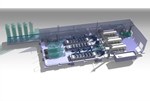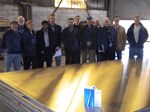The ITER Tokamak will rely on the largest cryogenic plant (cryoplant) infrastructure ever built. Three liquid helium plants, working in parallel, will provide a total average cooling capacity of 75 kW at 4.5 K and a maximum cumulated liquefaction rate of 12,300 litres/hour.
On Tuesday, 11 December, ITER Director-General Osamu Motojima and the Managing Director of Air Liquide Advanced Technologies, Xavier Vigor, signed the contract for ITER's three identical liquid helium (LHe) plants. The contract comprises the design, manufacturing, installation and commissioning of the LHe plants, which are adapted to the long-term, uninterrupted operation of the ITER Tokamak. The contract is worth EUR 83 million.
The cryoplant and cryo-distribution system will supply cooling for the ITER superconducting magnets to confine and stabilize the plasma. They will also provide the refrigeration for the cryosorption panels that are necessary to evacuate the helium ashes stemming from the fusion reaction and to assure the required vacuum for the cryostat and the vacuum vessel. All these users require helium cryogen at different temperature levels ranging from 4.5 K, to 50 K and up to 80 K.
The key design requirement is to cope with ITER's large dynamic heat loads ranging from 40 to 110 kW at 4.5 K mainly deposited in the magnets due to magnetic field variation and neutron production from deuterium-tritium fusion reactions. At the same time, the system must be able to cope with the regular regeneration of the cryopumps.
Manufacturing of the LHe plant main components will start after design finalization in 2014. The first compressor station will be delivered at the end of 2015 and the LHe plants will be ready for the cool-down of sub-systems in 2018.
"This is a major milestone not only for the cryogenic system but for the whole project," said the Head of the ITER Plant Engineering Division, Luigi Serio. "The contract covers the principal component that will drive the cool-down of the machine, seting the pace toward First Plasma."
"We are very happy and excited to participate in the great ITER adventure," Xavier Vigor said. "Be assured that we, the team from Air Liquide, are fully committed to making ITER a success."
Air Liquide is the world leader in gases for industry, health and the environment, and is present in 80 countries with 46,200 employees. Oxygen, nitrogen, hydrogen and rare gases have been at the core of Air Liquide's activities since its creation in 1902. In 2011, the Group's revenues amounted to EUR 14.5 billion, of which more than 80% were generated outside France.






